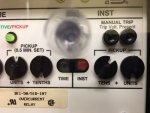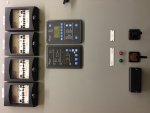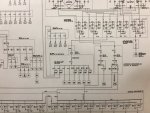ATSman
ATSman
- Location
- San Francisco Bay Area
- Occupation
- Electrical Engineer/ Electrical Testing & Controls
Had a customer call regarding the tripping of a C-H 4160V VCP vacuum breaker in a auto transfer scheme lineup. After checking the load (bldg power/lights, tel power) for evidence of a fault downstream he was able to reset the 86 LO relay without incident. About a month later the breaker tripped again and was reset. When I arrived onsite after the second trip I found the instantaneous target lit on the B phase Basler OC relay (see pics attached.) No other trip targets were lit on the other phase or ground OC relays which seems strange since most faults start as a ground fault.
We are scheduled to swap out the B phase relay today with a spare to rule out a defective relay. I spoke with a relay tester and he mentioned something about a problem that Basler had with this vintage OC relay (approx 14 yrs.) Had to do with the mis-firing of the SCR at the relay output.
Has anyone experienced a problem with this particular relay or any other protective relay. I have seen older W, GE, ITE and Hi-Z GFR's nuisance tripping but not a relay of this type. Any comments are welcomed.
Forgot to mention that there are no 4160V loads fed from this breaker, only 480V loads thru stepdown xfmrs.
We are scheduled to swap out the B phase relay today with a spare to rule out a defective relay. I spoke with a relay tester and he mentioned something about a problem that Basler had with this vintage OC relay (approx 14 yrs.) Had to do with the mis-firing of the SCR at the relay output.
Has anyone experienced a problem with this particular relay or any other protective relay. I have seen older W, GE, ITE and Hi-Z GFR's nuisance tripping but not a relay of this type. Any comments are welcomed.
Forgot to mention that there are no 4160V loads fed from this breaker, only 480V loads thru stepdown xfmrs.
Attachments
Last edited:



